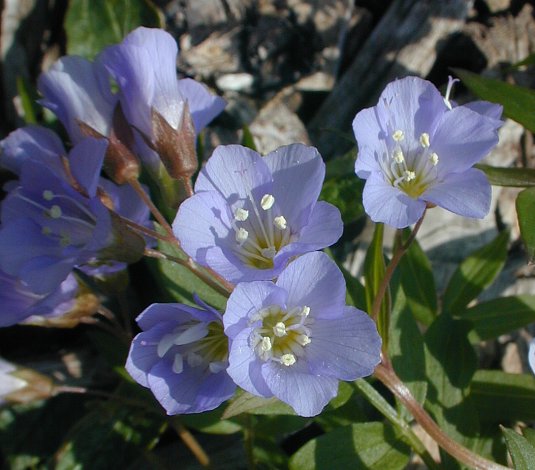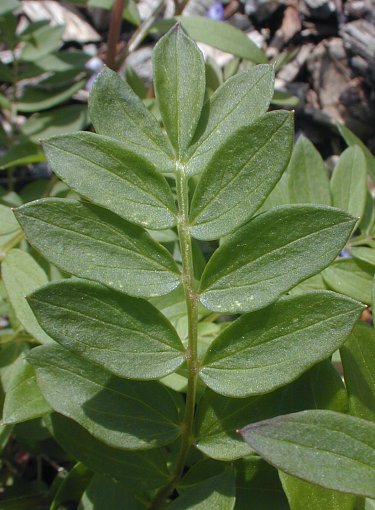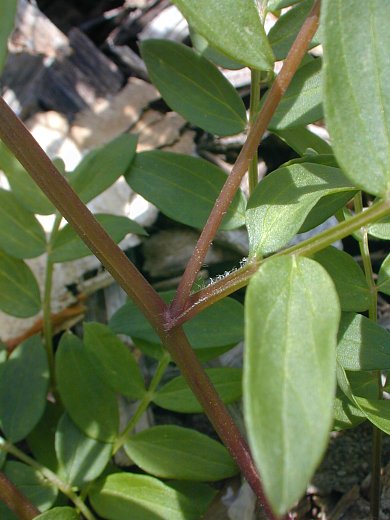Description: This herbaceous perennial plant is ½–1½' tall, branching occasionally. The leafy stems have a tendency to lean to one side or sprawl across the ground. The stems are light green to reddish green, glabrous to hairy, and often somewhat angular. The alternate compound leaves are simple odd-pinnate and up to 8" long, consisting of about 5-15 leaflets. The petioles and rachises of these compound leaves are light green to reddish green and glabrous to hairy; they are grooved above and convex below. The leaflets are ¾-1¼" long and about one-third as much across; they are elliptic to broadly elliptic-oblong, smooth (entire) along their margins, medium green, glabrous (or nearly so), and sessile (or nearly so). The upper stems terminate in rather loose panicles of floppy or nodding flowers spanning 1½-3" across. Some panicles are also produced from the axils of upper leaves on long peduncles up to 6" long. The pedicels are up to 1" long.

Both the peduncles and pedicels of these panicles are light green to reddish green and glabrous to hairy. The campanulate (bell-shaped) flowers are up to 16 mm. (2/3") across. Each flower has 5 rounded petals that are light blue-violet, a short-tubular calyx with 5 triangular teeth, 5 stamens with white anthers, and a pistil with a slender white style that become tripartite toward its tip. The calyx is light green to reddish purple and glabrous to hairy. There are fine veins that run along the length of the petals. The stamens are the same length as, or shorter than, the petals of the flowers. The blooming period usually occurs during the late spring, lasting about 2-3 weeks. Afterwards, the flowers are replaced by 3-celled seed capsules; these capsules are about 6 mm. (¼") in length and ovoid in shape; they are few-seeded. The root system consists of a short vertical crown with abundant fibrous roots. This plant spreads by reseeding itself.

Cultivation:
The preference is light shade or dappled sun, more or less mesic
conditions, and loamy soil with decaying organic matter. This plant is
not aggressive; it is able to adapt to somewhat shady gardens that are
located near deciduous trees.
Range & Habitat:
The native Jacob's Ladder is an occasional to locally common plant that
occurs in
most areas of Illinois, except for some counties in the central portion
of the state (see Distribution
Map).
Habitats include deciduous woodlands, lower wooded slopes, bases of
bluffs, shaded banks of streams and rivers, bottoms of
sandstone canyons, and areas along woodland paths. Jacob's Ladder is
found in higher quality natural habitats that are dominated by various
deciduous trees.

Faunal Associations: The nectar and pollen of the flowers attract bees primarily, including honeybees, bumblebees, little carpenter bees (Ceratina spp.), mason bees (Osmia spp.), cuckoo bees (Nomada spp.), Halictid bees (Augochlorella spp., Lasioglossum spp.), and Andrenid bees (Andrena spp.). A species from this last group, Andrena polemonii, is a specialist pollinator (oligolege) of Polemonium spp. (Jacob's Ladder, Greek Valerian). The flowers are also visited by Bombylius major (Giant Bee Fly), butterflies, skippers, and moths, which seek nectar. The larvae of two moths, Coleophora polemoniella and Scrobipalpula polemoniella, mine the leaflets. An aphid, Nasonovia hottesi, sucks the sap of these plants.

Photographic
Location:
A flower garden at Crystal Lake Park in Urbana, Illinois.
Comments:
This is a rather floppy plant, although both the flowers and foliage
are quite attractive. The bell-shaped flowers and compound leaves
together
provide Jacob's Ladder with a distinctive appearance. The only other
species that resembles it, Polemonium vanbruntiae
(Greek Valerian), which is native to some of the Eastern States,
doesn't occur in the wild in Illinois. This latter species is more
erect in habit, and it has slightly larger flowers with exerted
stamens.
The flowers of this latter species are usually a darker shade of blue
than those of Jacob's Ladder. The
common name of Polemonium reptans refers to the
pairs of opposite leaflets on the compound leaves, which supposedly
resemble a series of steps on a ladder in a dream by the biblical Jacob.